A Thorne–Żytkow object, also known as a hybrid star, is a conjectured type of star wherein a red giant or red supergiant contains a neutron star at its core, formed from the collision of the giant with the neutron star. Such objects were hypothesized by Kip Thorne and Anna Żytkow in 1977. In 2014, it was discovered that the star HV 2112, located in the Small Magellanic Cloud (SMC), was a strong candidate. Another possible candidate is the star HV 11417, also located in the SMC.
Be/X-ray binaries (BeXRBs) are a class of high-mass X-ray binaries that consist of a Be star and a neutron star. The neutron star is usually in a wide highly elliptical orbit around the Be star. The Be stellar wind forms a disk confined to a plane often different from the orbital plane of the neutron star. When the neutron star passes through the Be disk, it accretes a large mass of gas in a short time. As the gas falls onto the neutron star, a bright flare in hard X-rays is seen.
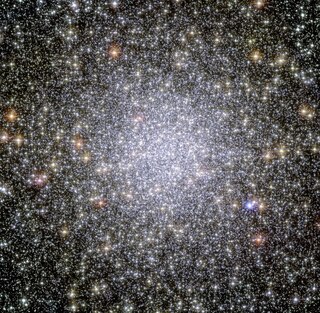
47 Tucanae or 47 Tuc is a globular cluster located in the constellation Tucana. It is about 4.45 ± 0.01 kpc (15,000 ± 33 ly) away from Earth, and 120 light years in diameter. 47 Tuc can be seen with the naked eye, with an apparent magnitude of 4.1. It appears about 44 arcminutes across including its far outreaches. Due to its far southern location, 18° from the south celestial pole, it was not catalogued by European astronomers until the 1750s, when the cluster was first identified by Nicolas-Louis de Lacaille from South Africa.

The first accreting millisecond pulsar discovered in 1998 by the Italian-Dutch BeppoSAX satellite, SAX J1808.4−3658 revealed X-ray pulsations at the 401 Hz neutron star spin frequency when it was observed during a subsequent outburst in 1998 by NASA's RXTE satellite. The neutron star is orbited by a brown dwarf binary companion with a likely mass of 0.05 solar masses, every 2.01 hours. X-ray burst oscillations and quasi-periodic oscillations in addition to coherent X-ray pulsations have been seen from SAX J1808.4-3658, making it a Rosetta stone for interpretation of the timing behavior of low-mass X-ray binaries.

GK Persei was a bright nova first observed on Earth in 1901. It was discovered by Thomas David Anderson, an Edinburgh clergyman, at 02:40 UT on 22 February 1901 when it was at magnitude 2.7. It reached a maximum magnitude of 0.2, the brightest nova of modern times until Nova Aquilae 1918. After fading into obscurity at about magnitude 12 to 13 during the early 20th century, GK Persei began displaying infrequent outbursts of 2 to 3 magnitudes. Since about 1980, these outbursts have become quite regular, typically lasting about two months and occurring about every three years. Thus, GK Persei seems to have changed from a classical nova like Nova Aquilae 1918 to something resembling a typical dwarf nova-type cataclysmic variable star.
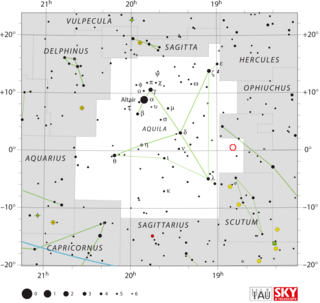
V603 Aquilae was a bright nova first observed in the constellation Aquila in 1918. It was the brightest "new star" to appear in the sky since Kepler's Supernova in 1604. Like all novae, it is a binary system, comprising a white dwarf and donor low-mass star in close orbit to the point of being only semidetached. The white dwarf sucks matter off its companion, which has filled its Roche lobe, onto its accretion disk and surface until the excess material is blown off in a thermonuclear event. This material then forms an expanding shell, which eventually thins out and disappears.
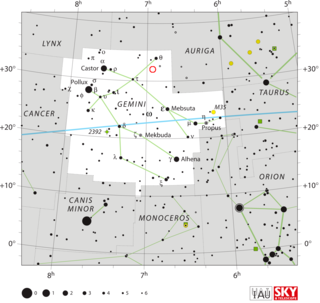
DN Geminorum or Nova Geminorum 1912 was a classical nova which lit up in 1912 in the constellation Gemini. It was discovered by Norwegian variable star observer Sigurd Einbu on March 12, 1912 before reaching peak brightness, which allowed early-stage spectra to be collected by Yerkes Observatory. The nova reached a maximum brightness of around 3.5 mag before declining, which means it was visible to the naked eye. Its brightness decreased over the following 36 days by 3 magnitudes as it gradually faded from sight. The light curve saw two maxima a few months after the outburst, along with strong oscillations. Today its brightness is visual magnitude 15.5.
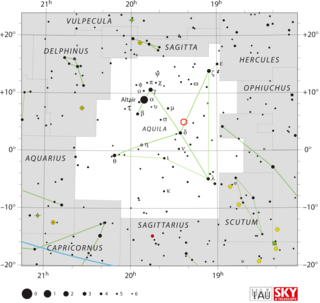
V1494 Aquilae or Nova Aquilae 1999 b was a nova which occurred during 1999 in the constellation Aquila and reached a brightness of magnitude 3.9 on 2 December 1999. making it easily visible to the naked eye. The nova was discovered with 14×100 binoculars by Alfredo Pereira of Cabo da Roca, Portugal at 18:50 UT on 1 December 1999, when it had a visual magnitude of 6.0.

Phi Aquilae, Latinized from φ Aquilae, is the Bayer designation of a binary star system in the equatorial constellation of Aquila. It has an apparent visual magnitude of +5.28 and is visible to the naked eye. With an annual parallax shift of 14.198 mas, this star is located at a distance of approximately 230 light-years from Earth. It is drifting closer with a radial velocity of –27 km/s. Based on its motion through space, this system is considered a possible member of the nearby Argus association of co-moving stars, although it may be too old.
LS I +61 303 is a microquasar, a binary system containing a massive star and a compact object. The compact object is a pulsar and the system is around 7,000 light-years away.

Vela X-1 is a pulsing, eclipsing high-mass X-ray binary (HMXB) system, associated with the Uhuru source 4U 0900-40 and the supergiant star HD 77581. The X-ray emission of the neutron star is caused by the capture and accretion of matter from the stellar wind of the supergiant companion. Vela X-1 is the prototypical detached HMXB.
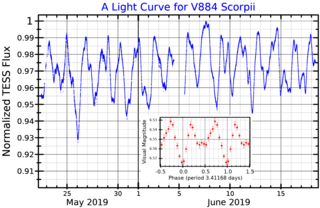
4U 1700-37 is one of the stronger binary X-ray sources in the sky, and is classified as a high-mass X-ray binary. It was discovered by the Uhuru satellite. The "4U" designation refers to the fourth Uhuru catalog.

X Persei is a high-mass X-ray binary system located in the constellation Perseus, approximately 950 parsecs away. It is catalogued as 4U 0352+309 in the final Uhuru catalog of X-ray objects.
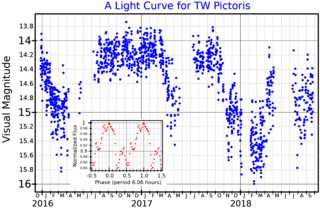
TW Pictoris is a 14th magnitude cataclysmic variable star system in the southern constellation of Pictor. It is located at a distance of approximately 1,430 light-years based on parallax measurements. Photometric observations in the visual band suggest a binary system with an orbital period of 6.06 hours. One of the components is an accreting white dwarf.

WR 20a is an eclipsing binary star belonging to or recently ejected from the young, massive cluster Westerlund 2. It was discovered in 2004 to be one of the most massive binary systems known, for which the masses of the components have been accurately measured.
BP Crucis is an X-ray binary system containing a blue hypergiant and a pulsar.

LL Andromedae is a dwarf nova in the constellation Andromeda, discovered during an outburst in 1979. Its typical apparent visual magnitude is 19.4, but undergoes outbursts events when can reach a peak magnitude of 14.3. Since this magnitude is reached during the most powerful outbursts, while less bright outbursts can occur, it is classified as a SU Ursae Majoris variable.

V1370 Aquilae, also known as Nova Aquilae 1982, is a nova that appeared in the constellation Aquila during 1982. It was discovered by Minoru Honda of Kurashiki, Japan at 20:30 UT on 27 January 1982. At that time the Sun had moved just far enough from Aquila to allow the nova to be seen in the morning sky. Although it was discovered photographically, its apparent magnitude was 6–7, making it potentially visible to the naked eye under ideal conditions. A possible magnitude 20 progenitor was located on the Palomar Sky Survey prints. Spectra of the object were taken in February 1982 at Asiago Astrophysical Observatory, which confirmed that it is a nova.

BG Canis Minoris is a binary star system in the equatorial constellation of Canis Minor, abbreviated BG CMi. With an apparent visual magnitude that fluctuates around 14.5, it is much too faint to be visible to the naked eye. Parallax measurements provide a distance estimate of approximately 2,910 light years from the Sun.

SW Ursae Majoris is a cataclysmic binary star system in the northern circumpolar constellation of Ursa Major, abbreviated SW UMa. During quiescence it has an apparent visual magnitude of 16.5–17, which is too faint to be visible to the naked eye. Based on parallax measurements, it is located at a distance of approximately 526 light years from the Sun.
















